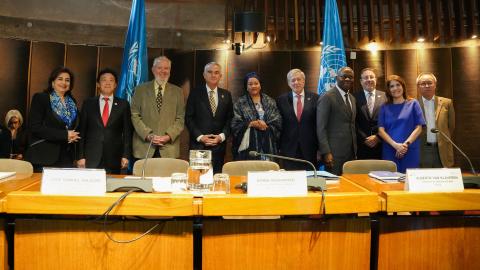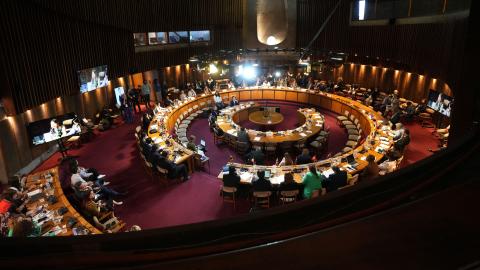Op-ed
(New York, 20 October) The lives of women and girls around the world have improved in several areas over the last 20 years, according to the new United Nations report The World’s Women 2015 launched today. Coming on the heels of the recently adopted Sustainable Development Goals (SDGs), this new set of data on women and girls worldwide brings into sharp perspective the need for gender equality outlined in Goal 5.
“We cannot achieve our 2030 Agenda for Sustainable Development without full and equal rights for half of the world’s population, in law and in practice,” said UN Secretary-General Ban Ki-moon at a recent event on gender equality organised on the side of the Sustainable Development Summit.
Women live longer lives, benefit from a better access to education and are more independent
Life expectancy has continued to rise, reaching 72 years for women and 68 for men, globally. Worldwide, the number of maternal deaths declined by 45% between 1990 and 2013. Although they continue to marry a few years earlier than men, women’s age at marriage has also increased, reflecting higher education levels, later entry into the labour force, as well as increased economic independence.
Enrolment of children in primary education is nearly universal today. The gender gap has narrowed and once they have enrolled in school, girls perform better than boys through primary education in two thirds of country. However in some developing countries the disparities against girls are stark. Today, 58 million children of primary school age are out of school worldwide. More than half of them are girls and nearly three quarters live in sub-Saharan Africa and Southern Asia. Although the vast majority of the world’s youth is currently literate, nearly two thirds of the world’s illiterate adults are women, a proportion unchanged for the last 20 years.
Many challenges remain to bridge the gap of gender equality by 2030. “Far too many women and girls continue to be discriminated against, subjected to violence, denied equal opportunities in education and employment, and excluded from positions of leadership and decision-making,” underscored Mr. Ban.
The persistence of gender-based violence and child marriage
Over one third of women worldwide have been a victim of physical and/or sexual violence at some point of their lives. In the most extreme cases, violence against women can lead to death; around two thirds of victims of intimate partner or family-related homicides are women. Attitudes towards violence are beginning to change as both men and women see violence against women less acceptable. But 60% of all women victims of violence still do not report it or seek any help.
Despite remaining a critical issue in Southern Asia and sub-Saharan Africa, child marriage has declined from 31% in 1995 to 26% in 2010.
Gender roles and lack of services affect the health of women and girls
Although the demand for family planning that are being met has increased in all developing regions, traditional gender roles and expectations associated with early marriage and lack of decision-making power among married girls increase their exposure to adolescent pregnancy, unsafe abortions and sexually transmitted infections, all important causes of death for women and girls in developing regions. Risk behaviours and image of masculinity have a harmful effect also on adolescents and young men who are at higher risk of dying from road injuries and self-harm. Men smoke tobacco and drink alcohol to a much greater extent of women, also contributing to their higher mortality rates.
Women’s heavy domestic burdens and economic dependency
Only 50% of women of working age are in the labour force, compared to 77 % of men. Women remain concentrated in low paid jobs and earn on average between 70 and 90% of what men earn.
Furthermore, women spend on average three hours more per day than men on household chores and caring for family members in developing countries and two hours more per day than men in developed countries. As a result of the gender division of paid and unpaid work, in many countries, women continue to be economically dependent on their spouses.
Women’s economic vulnerability becomes even more visible among lone mothers with children. One-parent household are increasingly common globally, both in developing and developed countries as a result of increased extramarital fertility and divorce. Lone mothers with children constitute about 75% of all one-parent households and suffer higher poverty rates than lone father or two parent households.
Unequal gender representation in leadership positions
In most societies around the world, women continue to have unequal voice in public and private spheres. The number of females among Heads of States or Governments is still an exception, although the world currently counts 19 female, a slight improvement compared to the 12 counted in 1995. Similarly, only 22% of parliamentarians and 18% of appointed ministers are women. Women’s representation among corporate managers, legislators and senior officials also remains low, with no country reaching or surpassing parity and only about half of countries having shares of 30% or more.
About the report
The World’s Women Report is prepared by the Statistics Division of the UN Department for Economic and Social Affairs (DESA) every five years. The publication is guided by the principles of the Beijing Declaration and Platform for Action adopted by countries at the 1995 UN Fourth World Conference on Women, aiming to remove all the obstacles to women’s active participation in all spheres of public and private life. Reviewing progress towards gender equality, the report presents the latest statistics and analyses of the status of women and men in eight critical areas of policy concern.
Marking the significantly increased availability of statistical data on gender issues over the past two decades, the World’s Women Report is launched on the occasion of the 2015 World Statistics Day (20 October) which highlights the importance of statistics in helping policy makers develop informed policies that impact millions of people worldwide.
The full report will be available in English starting 20 October 10:30 a.m. EST at: ://unstats.un.org/unsd/gender/worldswomen.html
Media Contacts
UN Department of Public Information
Mélanie Prud’homme, E: prudhommem@un.org, T: +1 (917) 367-3541
Ken Matsueda, E: matsueda@un.org, T: +1 (917) 367-5418
Available for interviews
- Ms. Ionica Berevoescu (English), Gender Statistics Expert, UN Statistics Division, UN Department of Economic and Social Affairs (DESA)
- Ms. Haoyi Chen (Chinese, English), Statistician, Social and Housing Statistics Section, UN DESA
- Ms. Francesca Grum (French, English) Chief, Social and Housing Statistics Section, UN DESA
- Mr. Lenni Montiel, (English, Russian, Spanish) Assistant Secretary-General for Economic Development, UN DESA
- Ms. Harumi Shibata Salazar (Spanish, English), Statistician, Social and Housing Statistics Section, UN DESA
Issued by the UN Department of Public Information.



